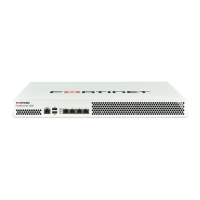System monitoring Page 96 FortiRecorder 2.4.2 Administration Guide
5. To display a column such as Time, mark the check box next to its name. To disable the
display of a column, clear its check box.
The page refreshes immediately, displaying the columns that you selected.
6. Column settings will not usually persist when changing pages, nor from session to session.
If you want to keep the settings, you must click Save View. The log view settings will not
apply to other accounts. Each administrator must configure their own settings.
To arrange the columns & rows
1. Hover your mouse cursor over the column heading.
2. Click and drag the column into the position where you want it to be.
3. Hover your mouse cursor over one of the column headings. An arrow will appear on the right
side of the heading. Click the arrow to display a drop-down menu, then click either Sort
Ascending or Sort Descending to cause the rows to be sorted from either first to last, or last
to first, based upon the contents of that column.
4. Column settings will not usually persist when changing pages, nor from session to session.
If you want to keep the settings, you must click Save View.
See also
• Logging
• Searching logs
• About logs
Downloading log messages
You can download logs that are stored locally (i.e., on the FortiRecorder appliance’s hard drive)
to your computer.
To download a log file
1. Go to one of the log types, such as Monitor > Log Viewer > Event.
2. In the list of log files, mark the check box of the log message that you want to download.
(You can only download one log file at a time.)
3. Click Download.
A drop-down menu appears.
4. Select either:
• Normal Format — A plain text .log file.
• CSV Format — A comma-separated values (CSV) file that can be opened in spreadsheet
software such as Microsoft Excel or OpenOffice Calc.
• Compressed Format — A plain text .log file in a .gz compressed archive.
5. If a file download dialog appears, choose the directory where you want to save the file.
Your browser downloads the log file. Time required varies by the size of the file and the
speed of the network connection.
See also
• Deleting log files
Deleting log files
If you have downloaded log files to an external backup, or if you no longer require them, you
can delete one or more locally stored log files to free disk space.

